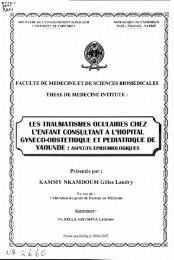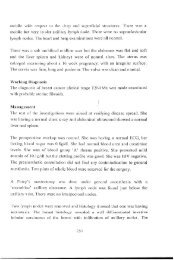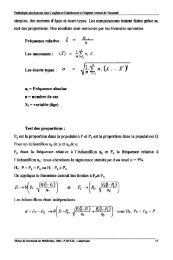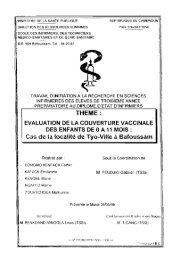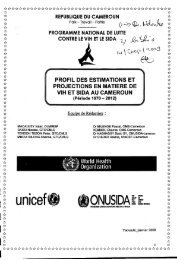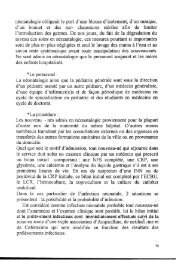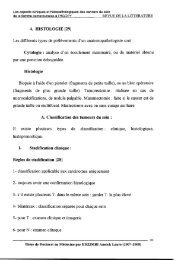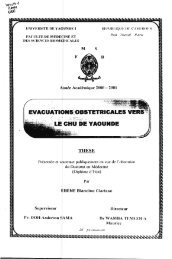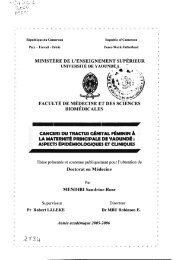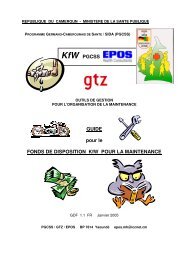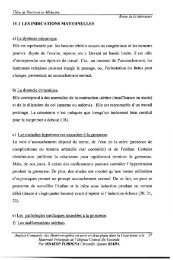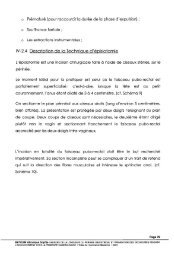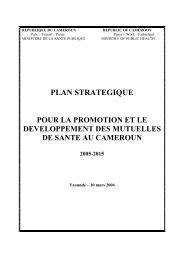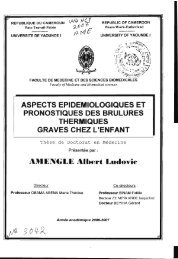seminaire atelier sur la planification par objectifs dans les districts ...
seminaire atelier sur la planification par objectifs dans les districts ...
seminaire atelier sur la planification par objectifs dans les districts ...
- No tags were found...
You also want an ePaper? Increase the reach of your titles
YUMPU automatically turns print PDFs into web optimized ePapers that Google loves.
BUREAUDE COORDINATION DES PROJETS SAN1'E (GTZ)HEALTH PROJEeTS' COORDINATION OFFICE (9TZ)KOORDINATIONSBÜRO GESUNDHEITSPROJEKTEB.P. 7814 Yaoundé, République du CamerounTel. : + 237 23 93 Il Fax.: +23723 23 72Email: gtz-sante@iccnet.cm 1 remo.meloni@camnet.cmConseiller technique Principal (GTZ) : Dr. Andreas StadIerDeutsche Gesellschaft fiIr TedmischeZusammenarbeit (GTZ) GmbHPN 95.2095.8SEMINAIRE ATELIER SUR LAPLANIFICATION PAR OBJECTIFSDANS LES DISTRICTS DE SANTEDE BUEA ET DE KUMBARapport rédigé <strong>par</strong> Christophe ATANGANA FUDAConsultant des Projets.DECEMBRE 1999.
Sommaire:1 ffiTRODUCTION 21.1 CONTEXTE DU SEMIN"AIRE ATELIER..•.•.....••...••.....•...••.......••••.........•........•...•......•••...•..••••••........ 21.2 PARTICIPANTS 21.3 OBJECTWS DU SEMmAIRE ATELIER 21.4 METHODOLOGIE....................................................................................................................•.........• 22 DEROULEMENT DES ACTIVITES ...........................................................................•....................... 32.1 JOUR 1 ...............•.••.••....•.•............••.......•••••........•••••••......•••..•..•..••...•.•••.••..••....•.•••••.••.•••••.•.....••••••.•••••••. 32.1.1 SESSION 1..•....•.•...•....••••....•••••••.........•.•............••..........•....••...••.....•••.•...•••.....•••.•••...•.••..•••..••••..••••.•.....• 32.1.2 SESSIONS 2 ET 3•...•....•••........•••..•.....•.••.•....•.....••.....•...•....•.••..•.••.•.•••......•••....••••.••••.•••.....••.••...•.....••.... 42.2 JOUR2 ••••••••••••.••••••.•••••••.••.•••.•••••••.••••.•.••.•••••••••••.••••.••••.••••.•••••.••••••••.•.•••••••.••••.••••••••.•••••..•••..•..••..•......• 52.2.1 SESSION 1......................•.•.....•.........•...•......................•..•....•.......•..••••...•.••..............••..•.....•..........•••.•...• 52.2.2 SESSION 2................................•.............••....•........•.........•...........••.........•...•...•...•....•....••............•...••..•.• 52.2.3 SESSION 3...••........•.•.••.....•................•..........•................••.....•.........•...................••.......•......................... 62.3 JOUR 3 ............................................•...............•........•........•.....................................•...•.....•................... 62.3.1 SESSION 1•••••••••.••••••••••••.••••.•••••••••••••••••••••••.•••••••••••••••••••••••••.•••••••••.•••••.••..••••.•••.•••••••••.••••••••.••••••••.....•• 62.3.2 SESSION 2••••••••••••••••••••••••••••••••••••••••••••••••••••••••••••••••••••••.•••••••••••••••••••••••••••••••••••••••••••••••••••••••••••••••••••••• 72.3.3 SESSION 3••.•.•.....•••...•....•••••••.••...•.••••.•.•.••.•.•••.•.•.•••..•.•••...••..••••.•....•••••.••••••.••..•••••..•...••••••••...••••..•••.••••.. 72.4 JOUR4 ••••••••••••••••••••••••••••••••••••••••••••••••••••.•••••••••••••.•••••••••••••••••••••••••••••••••••••••••••••••••••••••••••••.••••••••••••••••• 82.4.1 SESSION 1.•.••••••.••.••••••••••••...•••••.••••.•.....•••••.••.•.....••••••••.••.•••.•••••••••••...••••.••..••••••••.•••••••••••••••••••••••••••••.•.• 82.4.2 SESSION 2••••••••••••.•••••••••••••••••.•••••••••••••••••••••..••.••••••••••••••••••••.••••••••••••••••••••••••••••••••••••••••••••••••••••••••••••••• 82.4.3 SESSIONS 3 ET 4••••••••••••••••••••••••••••••••••••••••••••••••••••••••••••••••••.•••••••••••••••••••••••••••••••••••••••••••••.••••••.•••••••.•• 92.5 JOUR 5 ••••••••••••••••••••••••••.••••••••••••••••••••••••••••••••••••••••••••.••••••.•••.••••••••••••••• ~••••••••••••••••••••••.•••••••.•.•••••••••••••• 92.5.1 SESSION 1•••••••••••••••••••••••••••••••••••••••••••••••••••••••••••••.••••••••••••••••••••••••••••••••••••.••••••••••••••••••••••.••••••••••••••••••• 92.5.2 SESSION 2•••••••••••••••••••••••••••••••••••••••••••••••••••••••••••••••••••.•••••••••••••••••••••••••••••••.••••••••••••••••••••••••••••.•••••••••• 10A ,3 CLOTURE DU SEMINAIRE ATELIER••••.•••••••••••••••••••••••••••••••••••••••••••••••••••••••••••••••••••••••••••••••••••••• 104. ANNEXES........................•....•...........................................................................•.•.........•.........•......•...•... IlRapport Séminaire Atelier <strong>sur</strong> p<strong>la</strong>nification <strong>par</strong> <strong>objectifs</strong> KumbafBuea décembre 1999 Page 1 <strong>sur</strong> 29
SEMINAIRE ATELIER D'INITIATION DES MEMBRES DES EQUIPES CADRES DES DISTRICTS DESANTE DE BUEA ET DE KUMBA AUX TECHNIQUES DE PLANIFICATION PAR OBJECTIFS.1 INTRODUCTION1.1 CONTEXTE DU SEMINAIRE ATELIERDans le cadre des actions initiées en juillet 1999 pour le renforcement des capacitésgestionnaires des responsab<strong>les</strong> des <strong>districts</strong> de santé de Buéa et de Kumba, deux séminaires<strong>atelier</strong>s <strong>sur</strong> <strong>la</strong> p<strong>la</strong>nification <strong>par</strong> <strong>objectifs</strong> ont été organisés à Limbé, au Botanic Garden, àl'intention des responsab<strong>les</strong> de ces deux <strong>districts</strong> de santé. Le premier s'est déroulé du 07 auIl décembre 1999 pour Buéa et du 13 au 17 décembre 1999 pour Kumba.1.2 PARTICIPANTSOnt <strong>par</strong>ticipé à ces séminaires <strong>atelier</strong>s <strong>les</strong> membres des équipes cadres de chaque district desanté auxquels se sont ajoutés <strong>les</strong> chefs des centres de santé à intégrer au cours des troisprochaines années (soit trois <strong>par</strong> district). Un membre de <strong>la</strong> communauté de chaque aire desanté à intégrer a également été associé à ces travaux. La liste complète des <strong>par</strong>ticipants estdonnée en annexe au présent rapport.M. ATANGANA FUDA Christophe et le Dr YONDO David ont as<strong>sur</strong>é le rôle defacilitateurs.1.3 OBJECTIFS DU SEMINAIRE ATELIERAméliorer <strong>les</strong> connaissances et <strong>les</strong> capacités des <strong>par</strong>ticipants en matière de p<strong>la</strong>nification<strong>par</strong> <strong>objectifs</strong> <strong>dans</strong> le but de leur permettre :a) d'é<strong>la</strong>borer le p<strong>la</strong>n stratégique de développement de leurs <strong>districts</strong> de santé;b) d'é<strong>la</strong>borer leurs p<strong>la</strong>ns d'action opérationnels semestriels.1.4 METHODOLOGIEPour le bon déroulement de l'<strong>atelier</strong>, <strong>les</strong> facilitateurs ont pré<strong>par</strong>é <strong>les</strong> documents suivants:• « P<strong>la</strong>nifier <strong>les</strong> activités <strong>dans</strong> le district de santé» : document de référence résumant <strong>les</strong>principes et <strong>les</strong> outils essentiels de <strong>la</strong> p<strong>la</strong>nification <strong>par</strong> <strong>objectifs</strong>;• « Programme détaillé des activités» précisant pour chaque jour et pour chaque session <strong>les</strong>travaux à faire <strong>par</strong> chaque <strong>par</strong>ticipant;• «Carnet du <strong>par</strong>ticipant» : carnet de format pratique facilitant <strong>la</strong> prise de notes au<strong>par</strong>ticipant.Tous ces documents ont été traduits en ang<strong>la</strong>is pour mettre à l'aise tous <strong>les</strong> <strong>par</strong>ticipants.Les sessions comportaient un aspect «séminaire» au cours duquel, à l'aide d'unrétroprojecteur, <strong>les</strong> principes et <strong>les</strong> outils de p<strong>la</strong>nification étaient expliqués, et un aspect«<strong>atelier</strong>» au cours duquel <strong>les</strong> <strong>par</strong>ticipants cherchaient à appliquer ces principes et outils <strong>dans</strong>leur district de santé. La méthode « ZOPp» du brainstorming <strong>par</strong> cartes et pinboard a étéprivilégiée pour <strong>les</strong> recherches en groupes et <strong>les</strong> présentations en séances plénières.Le déroulement de ces activités est détaillé ci-après.Rapport Séminaire Atelier <strong>sur</strong> p<strong>la</strong>nification <strong>par</strong> <strong>objectifs</strong> Kumba/Buea décembre 1999 Page 2 <strong>sur</strong> 29
2 DEROULEMENT DES ACTIVITES2.1 Jour 1Ouverture du séminaire <strong>atelier</strong> : contexte, but, informations généra<strong>les</strong> et pratiques.2.1.1 Session 12.1.1.1 Thèmes:Qu'est-ce que p<strong>la</strong>nifier?Pourquoi p<strong>la</strong>nifier?2.1.1.2 Objectifs:a) Permettre aux <strong>par</strong>ticipants de donner une définition opérationnelle du terme« p<strong>la</strong>nifier» ;b) Leur permettre de distinguer entre <strong>la</strong> p<strong>la</strong>nification stratégique et <strong>la</strong> p<strong>la</strong>nificationopérationnelle ;c) Leur faire découvrir l'intérêt de <strong>la</strong> p<strong>la</strong>nification comme gage de succès de touteentreprise.2.1.1.3 Activités :2.1.1.3.1 C<strong>la</strong>rification des notions: Voir document de travail § 1.1 et 1.2; en abrégé: DT 1.1et 1.2.Une définition opératoire du concept « p<strong>la</strong>nification» a été expliquée <strong>sur</strong> <strong>la</strong> base d'exemp<strong>les</strong>familiers.Le processus de développement d'une entreprise ou d'un service a été présenté <strong>dans</strong> sesgrandes phases : enfance, ado<strong>les</strong>cence, maturité, avec <strong>les</strong> problèmes managériaux inhérents àchaque phase ainsi que leurs esquisses de solutions.2.1.1.3.2 Exercice de recherche en groupes : « Mon rêve <strong>sur</strong> le district de santé. »a) Quel<strong>les</strong> pourraient être, <strong>sur</strong> trois ans, <strong>les</strong> phases de développement de notredistrict de santé ?b) Quels problèmes majeurs pourrons-nous rencontrer à chaque phase?c) Quel<strong>les</strong> pourraient en être <strong>les</strong> esquisses de solutions?Cet exercice a permis aux <strong>par</strong>ticipants d'imaginer librement <strong>les</strong> grandes orientations quepourrait prendre leur district de santé et d'entrevoir <strong>les</strong> difficultés à affronter.2.1.1.3.3 Synthèse en plénière.Les productions des groupes ont montré de grandes ambitions des uns et des autres pour leurdistrict de santé. Les grands souhaits se résument ainsi :• Toutes <strong>les</strong> aires de santé bien structurées, correctement équipées et encadrées <strong>par</strong> unpersonnel sanitaire bien formé et motivé travail<strong>la</strong>nt en bonne entente avec unecommunauté initiée et engagée <strong>dans</strong> <strong>les</strong> prises de décisions sanitaires ;Rapport Séminaire Atelier <strong>sur</strong> p<strong>la</strong>nification <strong>par</strong> <strong>objectifs</strong> KumbaIBuea décembre 1999 Page 3 <strong>sur</strong> 29
2.2 Jour 22.2.1 Session 12.2.1.1 Thème: Choisir <strong>les</strong> problèmes importants2.2.1.2 Objectifs:a) Permettre aux <strong>par</strong>ticipants de distinguer entre <strong>les</strong> problèmes de santé et <strong>les</strong>problèmes de management ;b) Leur permettre d'adopter une démarche rationnelle et prudente <strong>dans</strong> l'analyse desproblèmes;c) Leur permettre d'identifier <strong>les</strong> problèmes prioritaires à l'aide d'une table despécification et <strong>sur</strong> <strong>la</strong> base de critères précis.2.2.1.3 Activités:2.2.1.3.1 C<strong>la</strong>rification des notions: DT3.1 à 3.6.Le concept de problème a été analysé. Le problème de santé et le problème de managementont été définis et différenciés. La méthode de définition d'un problème à l'aide duquestionnaire de Quintilien a été expliquée. Les erreurs à éviter <strong>dans</strong> <strong>la</strong> définition et <strong>la</strong>résolution du problème ont été concrètement présentées. Les critères de choix des problèmesprioritaires ont été définis et une grille ou table de spécification a été donnée comme outilpour le choix des problèmes prioritaires. Enfin on a appris a présenter <strong>les</strong> problèmes avecleurs re<strong>la</strong>tions de cause à effet sous forme d'arbre ou hiérarchie des problèmes.2.2.1.3.2 Exercice de recherche en groupes:Etude du cas « Zaka<strong>la</strong> ».Cet exercice a permis aux <strong>par</strong>ticipants de voir des exemp<strong>les</strong> concrets de problèmesmanagériaux, de bien distinguer, <strong>dans</strong> l'analyse d'un problème, entre <strong>les</strong> faits, le problème,ses causes et ses conséquences.2.2.2 Session 22.2.2.1 Thème: le même2.2.2.2 Activités :2.2.2.2.1 Exercice de recherche en groupes :Revoir <strong>la</strong> liste des problèmes du district de santé :a) En faire ressortir <strong>les</strong> problèmes de management;b) Etablir <strong>la</strong> liste des problèmes prioritaires de management ;c) Dresser l'arbre des problèmes prioritaires de management.Cet exercice très important a demandé beaucoup de temps aux <strong>par</strong>ticipants. Ceux-ci ontrencontré des difficultés à hiérarchiser <strong>les</strong> problèmes identifiés. On a cependant pu obtenirRapport Séminaire Atelier <strong>sur</strong> p<strong>la</strong>nification <strong>par</strong> <strong>objectifs</strong> KumbaIBuea décembre 1999 Page 5 <strong>sur</strong> 29
11pour chaque une liste de problèmes managériaux re<strong>la</strong>tifs à <strong>la</strong> structure du district de santé, auxprestations des soins de santé, à l'encadrement managérial et à l'organisation du <strong>par</strong>tenariat.2.2.3 Session 32.2.3.1 Thème: Fixer <strong>les</strong> <strong>objectifs</strong>. Développer <strong>les</strong> indicateurs de réalisation.2.2.3.2 Objectifs :a) Amener <strong>les</strong> <strong>par</strong>ticipants à formuler des <strong>objectifs</strong> corrects pour chaque problèmequ'ils sont appelés à résoudre;b) Les amener à prévoir pour chaque objectifun ou des indicateurs objectivementobservab<strong>les</strong> pour <strong>la</strong> me<strong>sur</strong>e des résultats des activités à déployer.2.2.3.31 Activités :2.2.3.3. C<strong>la</strong>rification des notions: DT4.1 à 4.5 ; 5.Le con ept d'objectif a été expliqué, <strong>les</strong> types d'<strong>objectifs</strong> définis et l'intérêt de <strong>la</strong> définitiondes obj ctifs établi. On a en outre insisté <strong>sur</strong> <strong>les</strong> exigences à respecter <strong>dans</strong> <strong>la</strong> formu<strong>la</strong>tion desobjecti spécifiques: qualités, éléments constitutifs. Enfin on s'est étendu <strong>sur</strong> <strong>la</strong> notiond'indiclteurs de réalisation.2.2.3.3. Exercice de recherche en groupes:a) Dresser l'arbre des <strong>objectifs</strong> correspondant à l'arbre des problèmesmanagériaux prioritaires ;b) Formuler pour chaque objectifun ou des indicateurs deréalisation objectivement observab<strong>les</strong>;c) Enoncer <strong>les</strong> sources de vérification de chaque indicateur.2.2.3.3.~ Cet exercice, pivot de tout l'<strong>atelier</strong>, a pris le meilleur temps des <strong>par</strong>ticipants. Eneffet, si des <strong>objectifs</strong> sont correctementformulés <strong>sur</strong> des problèmes bien identifiés, ildevient plusfacile d'imaginer <strong>les</strong> stratégies de solution de ces problèmes2.3 our 32.3.1 fession 12.3.1.11 Thème: Envisager <strong>les</strong> obstac<strong>les</strong> et <strong>les</strong> contraintes.2.3.1.~ Objectifs :r)Amener <strong>les</strong> <strong>par</strong>ticipants, lorsqu'ils é<strong>la</strong>borent un p<strong>la</strong>n d'action, à identifier toutes<strong>les</strong> difficultés qui peuvent entraver l'atteinte de leurs <strong>objectifs</strong> ~Leur permettre de choisir, à l'aide d'une table de spécification ou d'un arbre dedécision, <strong>par</strong>mi des alternatives d'action ou stratégies, celle qui est <strong>la</strong> plus2.3.1. Activités:2.3.1.3.} C<strong>la</strong>rification des notions: DT6.1 à 6.3.Rapport éminaire Atelier <strong>sur</strong> p<strong>la</strong>nification <strong>par</strong> <strong>objectifs</strong> KumbalBuea décembre 1999 Page 6 <strong>sur</strong> 29
Il a été expliqué <strong>la</strong> nécessité, <strong>dans</strong> une bonne p<strong>la</strong>nification, de prévoir <strong>les</strong> obstac<strong>les</strong> et <strong>les</strong>contraintes qui peuvent perturber l'atteinte des <strong>objectifs</strong> envisagés. Le concept d'alternatived'action ou stratégie a été étudié et deux outils ont été proposés aux <strong>par</strong>ticipants pour leurpermettre d'analyser <strong>les</strong> alternatives: <strong>la</strong> table de spécification et l'arbre de décision.2.3.1.3.2 Exercice de recherche en groupes :Etude du cas « Bua<strong>la</strong> ».2.3.1.3.3 Cet exercice devait permettre aux<strong>par</strong>ticipants d'utiliser <strong>les</strong> outils d'analyse desalternatives. Mais le temps matériel n'a pas permis de le conduirejusqu'au bout2.3.2 Session 22.3.2.1 Thème: le même2.3.2.2 Activités :2.3.2.2.1 Exercice de recherche en groupes :a) Partant d'un objectifdéjà formulé, identifier <strong>les</strong> suppositions éventuel<strong>les</strong>;b) développer <strong>les</strong> alternatives possib<strong>les</strong> d'action ou stratégies;c) choisir <strong>la</strong> stratégie <strong>la</strong> plus favorable;d) développer <strong>les</strong> activités liées à <strong>la</strong> stratégie retenue.2.3.2.2.2 Bien que non achevé, cet exercice a/ait mieux comprendre aux<strong>par</strong>ticipantsl'intérêt et <strong>la</strong> procédure d'analyse des alternatives.2.3.3 Session 32.3.3.1 Thème: Etablir le p<strong>la</strong>n d'action2.3.3.2 Objectifs :a) Amener <strong>les</strong> <strong>par</strong>ticipants à ordonnancer <strong>les</strong> activités et <strong>les</strong> tâches qu'ils ontformulées;b) Les amener à é<strong>la</strong>borer un p<strong>la</strong>n stratégique à moyen terme pour le développementde leur district de santé, en utilisant le diagramme de GANTT.2.3.3.3 Activités:2.3.3.3.1 C<strong>la</strong>rification des notions: DT 7.1 à 7.3La procédure d'énumération des activités à mener pour atteindre un objectifa été expliquée.L'intérêt et <strong>la</strong> méthode d'ordonnancement des activités ont été développés. Le diagramme deGANTT a été présenté.2.3.3.3.2 Exercice de recherche en groupes :a) Partant de <strong>la</strong> liste des <strong>objectifs</strong> managériaux précédemment dressée, énumérer <strong>les</strong> activitéspressenties pour chaque objectif;b) Ordonnancer <strong>les</strong> activités;Rapport Séminaire Atelier <strong>sur</strong> p<strong>la</strong>nification <strong>par</strong> <strong>objectifs</strong> KumbaIBuea décembre 1999 Page 7 <strong>sur</strong> 29
c) Proposer <strong>sur</strong> trois ans un p<strong>la</strong>n stratégique du développement du district de santé. Tracer àcet effet un diagramme de GANTT <strong>sur</strong> le formu<strong>la</strong>ire modèle remis <strong>par</strong> <strong>les</strong> facilitateurs.Cet exercice, l'un des <strong>objectifs</strong> majeurs de l'<strong>atelier</strong>, a permis de dresser une ébauche de p<strong>la</strong>nstratégique pour chaque district <strong>sur</strong> <strong>les</strong> trois prochaines années. Ces ébauches, é<strong>la</strong>borées sous<strong>les</strong> contraintes temporel<strong>les</strong> de l'<strong>atelier</strong>, pourront être revues à tête reposées <strong>par</strong> chaque district.El<strong>les</strong> sont jointes en annexe au présent rapport.2.4 Jour 42.4.1 Session 12.4.1.1 Thème: Le chemin critique PERT2.4.1.2 Objectifs:Initier <strong>les</strong> <strong>par</strong>ticipants à <strong>la</strong> technique PERT pour un suivi rigoureux de certainesactivités de leurs p<strong>la</strong>ns d'action.2.4.1.3 Activités :2.4.1.3.12.4.1.3.2C<strong>la</strong>rification des notions: DT 7.4Exercice de recherche en groupes :Exercice proposé <strong>dans</strong> le texte.2.4.1.3.3Synthèse en plénière.2.4.2 Session 22.4.2.1 Thème: le même2.4.2.2 Activités :2.4.2.2.1Exercice de recherche en groupes :a) Choisir une des activités précédemment énumérées.b) La détailler en tâches spécifiques ;c) Ordonnancer ces tâches ;d) Les représenter <strong>sur</strong> un diagramme PERT ;e) Fixer des durées à chaque tâche;f) Découvrir le chemin critique.L'exercice de p<strong>la</strong>nification stratégique ayant très <strong>la</strong>rgement empiété <strong>sur</strong> le quatrième jour, <strong>les</strong>explications et <strong>les</strong> exercices <strong>sur</strong> le PERT n'ont pas été approfondis. TI a été demandé aux<strong>par</strong>ticipants curieux d'en poursuivre l'étude, seuls ou en groupes.Rapport Séminaire Atelier <strong>sur</strong> p<strong>la</strong>nification <strong>par</strong> <strong>objectifs</strong> KumbalBuea décembre 1999 Page 8 <strong>sur</strong> 29
2.4.3 Sessions 3 et 42.4.3.1 Thème: E<strong>la</strong>borer le budget du programme2.4.3.2 Objectifs :a) Amener <strong>les</strong> <strong>par</strong>ticipants à procéder méthodiquement <strong>dans</strong> l'estimation des coûtsde chaque activité programmée ;b) Leur permettre ainsi d'é<strong>la</strong>borer un budget réaliste pour leur p<strong>la</strong>n d'action.2.4.3.3 Activités :2.4.3.3.1 Exercice de recherche en groupes :Suivre <strong>la</strong> procédure décrite au § 8.1 du document de travail pour estimer le coûtd'une activité dont <strong>les</strong> tâches auront été préa<strong>la</strong>blement ordonnancées. Commeactivité, il a été proposé aux <strong>par</strong>ticipants de « d'organiser un recensement sanitaire<strong>dans</strong> une aire de santé. »Pour cet exercice <strong>les</strong> <strong>par</strong>ticipants ont utilisé le formu<strong>la</strong>ire d'analyse « Estimation des coûtsd'une activité» proposé <strong>par</strong> <strong>les</strong> facilitateurs. Ds ont c<strong>la</strong>irenlent <strong>la</strong> nécessité de tout prévoirpour faire une estimation des coûts réaliste.2.5 Jour 52.5.1 Session 12.5.1.1 Thème: Identifier <strong>les</strong> sources de financement du p<strong>la</strong>n d'action dudistrict de santé.2.5.1.2 Objectifs :a) Permettre aux <strong>par</strong>ticipants de rechercher toutes <strong>les</strong> sources possib<strong>les</strong> definancement de leur p<strong>la</strong>n d'action;b) Les amener à programmer <strong>les</strong> activités à mener en vue d'une exploitationjudicieuse des sources de financement identifiées.2.5.1.3 Activités:2.5.1.3.1 Exercice de recherche en groupes:a) Analyser <strong>les</strong> stratégies de financement proposées au § 8.3 du DT.b) Pour chacune d'el<strong>les</strong>, décrire <strong>les</strong> activités à mener, <strong>les</strong> difficultés possib<strong>les</strong>, <strong>les</strong>réponses possib<strong>les</strong> à ces difficultés.2.5.1.3.2 Les stratégies suivantes ont été explorées et des résolutions prises pour chacuned'el<strong>les</strong>.a) Crédits de l'EtatRapport Séminaire Atelier <strong>sur</strong> p<strong>la</strong>nification <strong>par</strong> <strong>objectifs</strong> KumbalBuea décembre 1999 Page 9 <strong>sur</strong> 29
On a constaté que plus de 40% de ces crédits sont perdus pour des causes diverses. Parailleurs leur gestion donne beaucoup de soucis aux professionnels de santé et leur fait perdredu temps au détriment des soins aux ma<strong>la</strong>des. La désignation d'un gestionnaire unique pour ledistrict de santé pourrait, peut-être, apporter une solution appréciable à ces différentsproblèmes. Des garde-fous tels que <strong>la</strong> supervision permanente de l'équipe cadre de district, <strong>les</strong>uivi de <strong>la</strong> consommation des crédits <strong>par</strong> chaque bénéficiaire, etc. devraient être mis en p<strong>la</strong>cepour prévenir des abus. La réflexion doit se poursuivre pour l'adoption ou non d'un telsystème qui requiert <strong>les</strong> bonnes disposition de chaque intéressé.b) Recettes des formations sanitairesOn a aussi constaté beaucoup de déperditions <strong>dans</strong> <strong>les</strong> recettes des formations sanitaires. Lescauses de ces déperditions sont de différents ordres: le mauvais accueil des ma<strong>la</strong>des, <strong>la</strong>mauvaise gestion des fonds, le <strong>la</strong>xisme <strong>dans</strong> <strong>la</strong> procédure de payement des diversesredevance, etc. Une étude approfondie du problème devrait permettre de le mieux cerner pourle résoudre afin de maximiser <strong>les</strong> recettes de chaque formations sanitaire.c) Contributions des communautésSi <strong>les</strong> communautés sont associées à l'é<strong>la</strong>boration du p<strong>la</strong>n d'action, el<strong>les</strong> seront disposées à<strong>par</strong>ticiper à son exécution suivant leurs moyens: investissement humain, dons en nature,financement <strong>par</strong>tiel.d) Système interne de financementL'idée a germé que le district de santé pourrait disposer d'un fonds interne pour lefinancement de ses p<strong>la</strong>ns de développement sanitaire. Chaque formation sanitaire devraitconcourir à <strong>la</strong> constitution de ce fonds <strong>dans</strong> des conditions qu'il convient d'étudier et dedéfinir. Une étude est également demandée à ce sujet.e) Contributions des <strong>par</strong>tenaires extérieurs.Après exploitation des disponibilités loca<strong>les</strong>, il reste <strong>la</strong> possibilité de solliciter l'interventionde <strong>par</strong>tenaires extérieurs qui pourraient apporter leurs contributions sous forme desubventions <strong>sur</strong>tout pour <strong>les</strong> gros investissements (infrastructures, gros équipement), ou sousforme de prestations de services <strong>dans</strong> des études ou <strong>dans</strong> <strong>la</strong> formation.2.5.2 Session 23 CLOTURE DU SEMINAIRE ATELIERL'évaluation du séminaire <strong>atelier</strong> faite <strong>par</strong> chaque <strong>par</strong>ticipant a fait ressortir <strong>les</strong> pointssuivants:Les enseignements ont été très enrichissants et adaptés aux besoins des <strong>par</strong>ticipants;• La méthode pédagogique employée a permis à chaque <strong>par</strong>ticipant de progresser; il estcependant souhaité que, pour l'avenir, <strong>les</strong> documents importants soient traduits et remis àtemps aux <strong>par</strong>ticipants; il est aussi souhaité que <strong>la</strong> programmation permette de mener àleurs fins <strong>les</strong> exercices prévus ;• Les outils et principes de p<strong>la</strong>nification donnés sont pratiques: <strong>les</strong> <strong>par</strong>ticipants sontdisposés à <strong>les</strong> utiliser désormais ;Rapport Séminaire Atelier <strong>sur</strong> p<strong>la</strong>nification <strong>par</strong> <strong>objectifs</strong> KumbaIBuea décembre 1999 Page 10 <strong>sur</strong> 29
• Les exercices faits en <strong>atelier</strong> ont permis aux <strong>par</strong>ticipants d'ébaucher méthodiquement leursp<strong>la</strong>ns d'action immédiats et de suivre une dén<strong>la</strong>rche systématique <strong>dans</strong> l'é<strong>la</strong>boration deleurs d'action futurs.• Les budgets obtenus <strong>sur</strong> <strong>la</strong> base des p<strong>la</strong>ns ainsi é<strong>la</strong>borés sont réalistes et réalisab<strong>les</strong>suivant <strong>les</strong> stratégies de financement imaginées qui seront développées.• Les <strong>par</strong>ticipants souhaitent unanimement que des formations simi<strong>la</strong>ires leur soientrégulièrement dispensées pour renforcer leurs capacités <strong>dans</strong> tous <strong>les</strong> domaines demanagement sanitaire.Rapport Séminaire Atelier <strong>sur</strong> p<strong>la</strong>nification <strong>par</strong> <strong>objectifs</strong> KumbaIBuea décembre 1999 Page Il <strong>sur</strong> 29
4 ANNEXESPLAN STRATEGIQUE BUEA POUR 2000-2002PLAN STRATEGIQUE KUMBA POUR 2000-2002Rapport Séminaire Atelier <strong>sur</strong> p<strong>la</strong>nification <strong>par</strong> <strong>objectifs</strong> KumbalBuea décembre 1999 Page 12 <strong>sur</strong> 29
STRATEGIC PLAN OF THE BUEA HEALTH DISTRICT JAN 2000-DEC 2002Global objective : Improve the health ofthe popu<strong>la</strong>tions within the Buea Health District with theirfull <strong>par</strong>ticipationHEALTH SYSTEM Global sub objective: Rationalise health care delivery within the Buea Health 11/12/1999... ... ... ..... District. ..................1. - STRUCTURAL ORGANISATION Of HEALTH SYSTEM IN BUEA HEALTH DISTRICTPROBLEMS OBJECTIVES INDICATORS SOURCES OF ACTIVITIES RESPON PLANNINGVERIFICATIONSmLE1. The Buea Heath District is RenderBueanot completely viable. Heath Districtcompletelyviable beforeJune 200200 01 02Rapport Séminaire Atelier <strong>sur</strong> p<strong>la</strong>nification <strong>par</strong> <strong>objectifs</strong> Kumba/Buea décembre 1999 Page 13 <strong>sur</strong> 29
1.1. The socio-economic health Make Data Data base at a) Organise health census in the HIA to be DMüenvironment is not weIl avai<strong>la</strong>ble avai<strong>la</strong>ble alllevel integrated ;known.sociob)economicCarry out the inventory ofthe equipment ;a) There is no basic data health data of c) Asses the purchasing power ofthethe district. -popu<strong>la</strong>tions and the financial capacities ofb) There is no follow up systemservlces;ofthe movement ofthepopu<strong>la</strong>tions d) Asses the behaviour ofthe popu<strong>la</strong>tions -towards health ;e) Identify the channel ofcollection andtransmission ofthe information;f) Establish follow up system ofhealth andsocio economic evolution within the district.1.2..Resources are insufficient Make Necessary Data base at a) Complete or renew equipment for the healthavai<strong>la</strong>ble resources allievei institution to be made viable.a) The equipment is not enough human avai<strong>la</strong>ble atfor p<strong>la</strong>nned activities resources and alllevei b) Train staffand <strong>par</strong>tners towards reorientationb) Personal and <strong>par</strong>tners are notreoriented to PRCc) The avai<strong>la</strong>ble staff strengthdoes not meet up withqualitative needsequipmentPRec) Put in p<strong>la</strong>ce gradually the adequate humanresourcesRapport Séminaire Atelier <strong>sur</strong> p<strong>la</strong>nification <strong>par</strong> <strong>objectifs</strong> KumbaIBuea décembre 1999 Page 14 <strong>sur</strong> 29
Il. - RATIONALISATION OF HEALTH CARE OELIVERY IN HEALTH UNITS IN BUEA HO.PROBLEMS OBJECTIVES INDICATORS SOURCES OF ACTIVITms RESPONSmLE PLANNINGVERIFICATION2. Curative, Ameliorate thepreventive and quality of thepromotional quality services ln thehealth care delivery health units1S not yetsatisfactory00 01 021.....--2.1. The existing Reorient aIl health a) HDMT functional ; a) Team contract a) Organise the DMOhealth units are not units before HDMTyet reoriented December 2002 b) DR performant ~ b) District action CMOp<strong>la</strong>nb) Renovate the DHc) DRS operational ; 3 2 2c) Reports of c) Integrate 7 HIAcl) 7 HIA integrated activities ;d) Evaluationreports.Rapport Séminaire Atelier <strong>sur</strong> p<strong>la</strong>nification <strong>par</strong> <strong>objectifs</strong> KumbaJBuea décembre 1999 Page 15 <strong>sur</strong> 29
2.2. There IS poor Ameliorate the a) Utilisation rate of a) Consultation a) Define patient flow copreception of quality of reception H/U register in eachH/Upatient ln the : CMOhealth units b) Existence of bill b) H/U Statisticsa) Patients are weIl board b) Organise Rand C/Roriented within system DMOthe H/U ~b) Waiting time isreduced.2.3. Diagnostics and Rationalise a) Number of a) Supervision a) E<strong>la</strong>borate norms and DMOtreatment of diagnostics and therapeutic reports protocolsdiseases are not treatment guidelines avai<strong>la</strong>blerationalised inHIU b) Report of b) Train healtha) Make avai<strong>la</strong>ble training personal onnorms and b) Number of health utilisation of normsprotocols personal uSlng and protocoltherapeuticb) P<strong>la</strong>n periodic guidelines. c) Supervise regu<strong>la</strong>rlyref<strong>les</strong>hial coursec) Number of personalretrainedRapport Séminaire Atelier <strong>sur</strong> p<strong>la</strong>nification <strong>par</strong> <strong>objectifs</strong> KumbaIBuea décembre 1999 Page 16 <strong>sur</strong> 29
2.4. The continuity of En<strong>sur</strong>e the a) 24 h coverage Evaluation report a) Put in p<strong>la</strong>ce a shift DMOhealth care delivery continuity of healthsystemis not en<strong>sur</strong>ed care delivery b) Rand C/R system isfunctionalb) Organise Rand C/Rwithin the districtc) uniform medicalbook for the districtc) Introduce a uniformmedical book forthe follow up ofthepatient.2.5. Health care Organise health care a) Priee list put up Price list a) E<strong>la</strong>borate price list DMOfinancing is not financing at ailleveiorganised b) Health care delivery Evaluation report CMOaccessible to ail b) Put ln p<strong>la</strong>ce awithout financial simplified system ofbarrier. payment of healthcare deliveryc) Put in p<strong>la</strong>ce asystem formanagement ofsocial cases.Rapport Séminaire Atelier <strong>sur</strong> p<strong>la</strong>nification <strong>par</strong> <strong>objectifs</strong> KumbaIBuea décembre 1999 Page 17 <strong>sur</strong> 29
III. - REINFORCE1\ffiNT OF MANAGERIAL CAPACITIES IN BUEA lID.PROBLEMS OBJECTIVES INDICATORS SOURCES OFVERIFICATIONACTIVITIES RESPONsm 1 PLANNINGLE00 101 1023. Managerial capacitiesare weak at alllevel.Improve managerialcapacities3.1. Technical know how Improve technical Number of personall Report oftrainingon treatment of know how on trained on datainformation is limited treatment of analysisinformationOrganise course onmanagement information :- Identify training needsDMO.---Train3.2. The techniques of Improve techniques 1a) Updated financiall Financial journalfinancial ~anagement of financial records;are limitedmanagement3.2.1 The system ofrevenue collection is notweIl organised3.2.2. The system ofexpenditures is not weIlorganised3.3. Techniquessupervision aresufficientofl Improve techniquesnot ofsupervisionb) Payment ofservIces and 1Receipt bookletproper receiptissued.Chrono forc) Justification 1justificationdocuments for aIl documentsexpenditureavai<strong>la</strong>ble.Number of personalretrained onsupervisIona) Organise system of incorne 1DMO; CMOb) Organise system ofl COPexpendituresa) E<strong>la</strong>borate guidelines forsupervisionb) Organise training session onsupervIsIon1--1---1--Rapport Séminaire Atelier <strong>sur</strong> p<strong>la</strong>nification <strong>par</strong> <strong>objectifs</strong> KumbaIBuea décembre 1999 Page 18 <strong>sur</strong> 29
IV. - ORGANISATION Of PARTNERSHIPPROBLEMS OBJECTIVES INDICATORS SOURCES OF ACTIVITIES RESPONSIB PLANNINGVERIFICATIONLE4 The <strong>par</strong>tnership Render <strong>par</strong>tnership 00 01 02between health functional.services and :- Community- Re<strong>la</strong>ted sectorsIs no t functional4.1. The community is Render dialogue a) Number ofmeetings a) Reports of a) Revise dialogue structures DMOnot sufficiently structures functional;meetingsb) Number ofb) Reorientate members ofinvolved in healthdecisions initiate by b) Reports of dialogue structures towardsactivitiesdialogue structure training PRec) Reports of c) Reinforce the commitmentactivities ofdialogue structuresmembers.4.2. There is no Put in p<strong>la</strong>ce effective co- a) Number ofco- Reports of a) Create a co-ordination DMO -effective co- ordination between ordination meetings meetings structure between healthordination between health providersprovidersb) Number ofhealth providers.decisions taken b) Supervise the various -during the meetingshealth services providersc) Develop a frame work withtraditional practitionerRapport Séminaire Atelier <strong>sur</strong> p<strong>la</strong>nification <strong>par</strong> <strong>objectifs</strong> KumbaJBuea décembre 1999 Page 19 <strong>sur</strong> 29
4.3. There is no Establish an effective c) Number ofco- Reports of a) Initiate intersectorial DMOintersectorial intersectorial framework. ordination meetings meetings col<strong>la</strong>boration meetings ;col<strong>la</strong>borationNumber ofdecisionsb) Associate re<strong>la</strong>ted and socialtaken during thesectors in the p<strong>la</strong>nning ofmeetingshealth activities..Rapport Séminaire Atelier <strong>sur</strong> p<strong>la</strong>nification <strong>par</strong> <strong>objectifs</strong> KumbaJBuea décembre 1999 Page 20 <strong>sur</strong> 29
STRATEGIC PLAN OF THE KUMBA HEALTH DISTRICT JAN 2000-DEC 2002Global objective: Improve on the health status ofthe popu<strong>la</strong>tion within Kumba Health District with theirfull <strong>par</strong>ticipationHEALTH SYSTEM Global sub objective: Rationalise health care delivery within the Kumba Health 17/12/1999.............. District. ..................1. - STRUCTURAL ORGANISATION Of HEALTH SYSTEM IN KUMBA HEALTH DISTRICTPROBLEMS OBJECTIVES INDICATORS MEANSOF ACTIVITIES RESPON PLANNINGVERIFICATIONSmLE2. The Kumba Heath District Render Kumbais not completely viable. Heath Districtcompletelyviable beforeJune 200200 01 021.1. The socio economic Make avai<strong>la</strong>ble Data Data base at g) Organise health census in the HIA to behealth environment is not socio economic avai<strong>la</strong>ble alllevei integrated ;DMOweIl known.health data oftheh) Carry out the inventory ofthe equipment ;district.c) There is inadequate basic -i) Asses the purchasing power ofthedatapopu<strong>la</strong>tions and the financial capacities of-services;d) There is no follow upsystem ofthe movement ofj) Asses the behaviour ofthe popu<strong>la</strong>tionsthe popu<strong>la</strong>tions towards health ;Rapport Séminaire Atelier <strong>sur</strong> p<strong>la</strong>nification <strong>par</strong> <strong>objectifs</strong> KumbaIBuea décembre 1999 Page 21 <strong>sur</strong> 29k) Institute the channel ofcollection andtransmission ofthe information;1) Establish follow up system ofhealth and
PROBLEMS OBJECTIVES INDICATORS MEANSOF ACTIVITIES RESPON PLANNINGVERIFICATIONSmLEsocio economic evolution within the district.00 01 021.2.Resources are insufficient Make avai<strong>la</strong>ble %of - Inventory d) Complete and/or renew equipment andsufficient human required records logistics for the health unit.d) There is no adequateresources and resourcesinfrastructureinfrastructure avai<strong>la</strong>ble - Personnel e) Put in p<strong>la</strong>ce appropriate human resourcesindex carde) Deployment ofhuman t) Renovate and/or rebuild appropriateresources does notinfrastructureconsider quality and/orquantityf) AlI necessary technicalequipment for health caredelivery are not avai<strong>la</strong>bleg) The means oftransport areinadequate3. Health servcices are not Health services Functional Document a) Draw up an organigramme for aIl health unitsr---weIl organised are better organigram within the districta) Personnel and <strong>par</strong>tners areorganised meb) Train staffand <strong>par</strong>tners on reorientation PRe-not reoriented to the-district health systemc) Set up internaI mIes and regu<strong>la</strong>tions at alllevels and structuresb) InternaI mIes andregu<strong>la</strong>tions forfunctionning ofservicesare avai<strong>la</strong>ble for useRapport Séminaire Atelier <strong>sur</strong> p<strong>la</strong>nification <strong>par</strong> <strong>objectifs</strong> KumbaJBuea décembre 1999 Page 22 <strong>sur</strong> 29
PROBLEMS OBJECTIVES INDICATORS MEANSOF ACTIVITIES RESPON PLANNINGVERIFICATIONSIBLE4. Provinci<strong>la</strong>l support to Assumption: provincial support to KumbaKumba health districtdistrict health activities are strengthenedhealth activities is weak00 01 02a) Provinciallevel is notinvolved in the districtdevelopment andoperationa p<strong>la</strong>nsb) Provincial suppervision tothe district is irregu<strong>la</strong>r1---5. The maintenance system is Establish a weil Frequency of Observation a) Set up an equipped maintenance unitnot weIl organised organised breakdown and reportsmaintenance is reducedb) Train user on the appropriate use ofsystemequipment and logisticc) Make avai<strong>la</strong>ble s<strong>par</strong>e <strong>par</strong>tsd) Put in p<strong>la</strong>ce a financial system to sustainmaintenance unit-Il. - RATIONALISATION OF HEALTH CARE OELIVERY IN HEALTH UNITS IN KUMBA HO.PROBLEMS OBJECTIVES INDICATORS MEANS OF ACTIVITIES RESPONSIB PLANNINGVERIFICATIONLERapport Séminaire Atelier <strong>sur</strong> p<strong>la</strong>nification <strong>par</strong> <strong>objectifs</strong> KumbaIBuea décembre 1999 Page 23 <strong>sur</strong> 29
2.I.Patient flow To en<strong>sur</strong>e the % ofreferral and % Documents a) Determine modalitieswithin the district continuity ofcare counter referral patient flow in eachis not weil between the two health unit/serviceorganised levelsb) Establish a conducivea) Patients are not environment for patientweil receivedc) Reorganised theb) The referral and referral and countercounter referralsystem is not weilorganisedreferral systemd) Establish a patientdocumentation systemc) Emergency andOPED is note) Produce guidelines forfunctional in the the management of -districtemergencies OPED2.2. health units have Reorient aIl health % ofhealth units Reports d) Update health area mapnot been units before reorientatedreorientated December 2002 e) Tarify medical acts andservices at aIl levelsa) Health areas are notweil demarcatedf) Put in p<strong>la</strong>ce a goodsystem ofrevenueb) Health personnel collection and paymentr--and communityfor servicesrepresentatives arenot reorientatedRapport Séminaire Atelier <strong>sur</strong> p<strong>la</strong>nification <strong>par</strong> <strong>objectifs</strong> KumbaIBuea décembre 1999 Page 24 <strong>sur</strong> 29g) Establish a system formanagement "social"00 01 02
PROBLEMS OBJECTIVES INDICATORS MEANSOF ACTIVITIES RESPONSm PLANNINGVERIFICATIONLEc) Health carefinancing system isnot organisedd) There are no basicguidelines forhealth care deliverycasesh) En<strong>sur</strong>e the use ofguidelines for healthcare delivery at aillevei"'''' vv"' ..V~ 022.3 the health district The health district is c) Ministerial decision Reports c) Pre<strong>par</strong>e the document -ofKumba is too split into two exposing the necessity<strong>la</strong>rge (1 7 health d) ProposaI for the ofthe splitareas) split -d) Write a letterRapport Séminaire Atelier <strong>sur</strong> p<strong>la</strong>nification <strong>par</strong> <strong>objectifs</strong> KumbaIBuea décembre 1999 Page 25 <strong>sur</strong> 29
III. - REINFORCEMENT OF MANAGERIAL CAPACITIES IN KUMBA HO.PROBLEMS OBJECTIVES INDICATORS MEANSOF ACTIVITIES RESPONSIB PLANNINGVERIFICATIONLE3.1. the techniques of En<strong>sur</strong>e that the a) % ofp<strong>la</strong>nned Supervision and a) Train responsible in healthmanagement ofhealth techniques activity reports activity reports units/services onand health services management management techniquesactivities are not techniques of b) number ofmastered at aIl levels management of decisions based b) Train supervisors at aH r--health services on facts gained levelsa) Follow up system for the activities are trom dataexecution ofp<strong>la</strong>nned mastered at aH analysis c) Organise regu<strong>la</strong>ractivities is weak levels supervision00 01 02b) P<strong>la</strong>nning ofactivities is d) Organise a training on the - -not carried out at aIlmanagement ofinformationlevelsc) The techniques ofsupervision are notmastered at ailleveisd) The process ofevaluation ofresults isweake) The process ofhealthinformation managementis deficient3.2 The system ofresource En<strong>sur</strong>e that the Procedure of Documents and a) Train leaders on leadershipRapport Séminaire Atelier <strong>sur</strong> p<strong>la</strong>nification <strong>par</strong> objeetifs KumbaIBuea décembre 1999 Page 26 <strong>sur</strong> 29
PROBLEMS OBJECTIVES INDICATORS MEANSOF ACTIVITIES RESPONSm PLANNINGVERIFICATIONLEmanagement is not system ofresource resource reports techniquesrationalised management is management arerationalised avai<strong>la</strong>ble b) Put in p<strong>la</strong>ce an organiseda) Leadership techniques system ofrevenueare not sufficientlycollectionmastered at aillevelsc) Put in p<strong>la</strong>ce an organisedb) System ofrevenue system ofexpenditurecollection is not weIlorganisedc) The system ofexpenditure is not weilorganisedd) Personnel is notsufficiently motivatede) The management ofmaterial resources isdeficientd) Put in p<strong>la</strong>ce a system ofmotivatione) Put in p<strong>la</strong>ce a system for themanaghement ofmaterialresources00 01 02Rapport Séminaire Atelier <strong>sur</strong> p<strong>la</strong>nification <strong>par</strong> <strong>objectifs</strong> KumbaIBuea décembre 1999 Page 27 <strong>sur</strong> 29
IV. • ORGANISATION Of PARTNERSHIPPROBLEMS OBJECTIVES INDICATORS MEANSOF ACTIVITIES RESPONSm PLANNINGVERIFICATIONLE4.1 community is not fully AlI dialogue a) %of a) Report of a) Information and mobilisation ofinvolved in the management structure dialogue activity communityofthe health district made structures~functional functional b) Report of b) Organise election ofcommunitysupervision representativesb) %ofp<strong>la</strong>nnedc) Train dialogue structuresactivitiesd) Organise election intomanagement committeee) Train management committeet) Install membersg) Supervision ofhealth committeeactivities00 01 02Rapport Séminaire Atelier <strong>sur</strong> p<strong>la</strong>nification <strong>par</strong> <strong>objectifs</strong> Kumba/Buea décembre 1999 Page 28 <strong>sur</strong> 29
4.2 Intra sectoral col<strong>la</strong>boration is Improve on Concertation Reports of a) Organise information andnot weIl organised intra sectorial meeting meetings concertation meetingscol<strong>la</strong>borationa) There is poor col<strong>la</strong>boration b) Establish modalities forbetween public and privatecol<strong>la</strong>borationhealth sectorsb) There is weak col<strong>la</strong>borationbetween traditional healers andmodern health sectors4.3 Inter sectoral col<strong>la</strong>boration is Improve on a) Regu<strong>la</strong>rityof Reports and a) Organise information exchangenot weIl organised the Inter meetings minutes of meetingssectoralmeetingscol<strong>la</strong>boration b) Concerted b) Identify areas ofcol<strong>la</strong>borationaction p<strong>la</strong>n-c) Establish modalities forcol<strong>la</strong>borationd) Set up a concerted p<strong>la</strong>n ofaction4.4 Inter district col<strong>la</strong>boration no Share a) Regu<strong>la</strong>rityof a) Reports Organise at least one meeting forlonger exists experiences meetings exchange ofexperiences a year withwith other b) Documents other <strong>districts</strong><strong>districts</strong> b) Experiencesdisseminated c) minutesRapport Séminaire Atelier <strong>sur</strong> p<strong>la</strong>nification <strong>par</strong> <strong>objectifs</strong> KumbaIBuea décembre 1999 Page 29 <strong>sur</strong> 29



